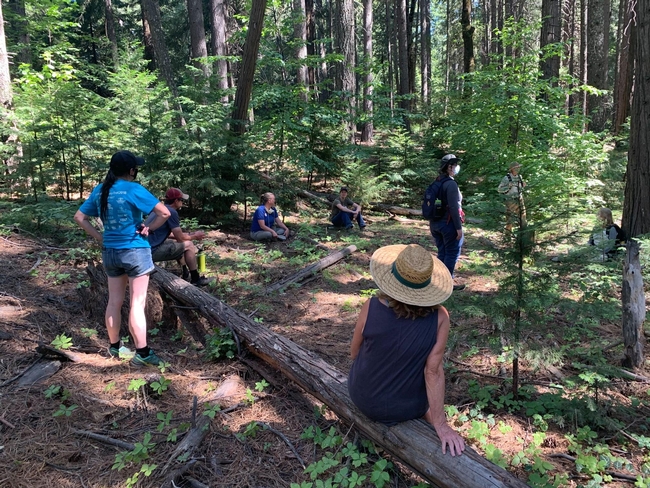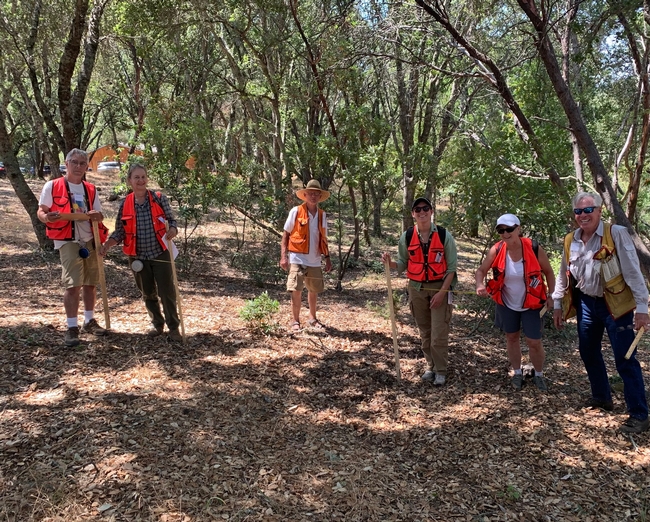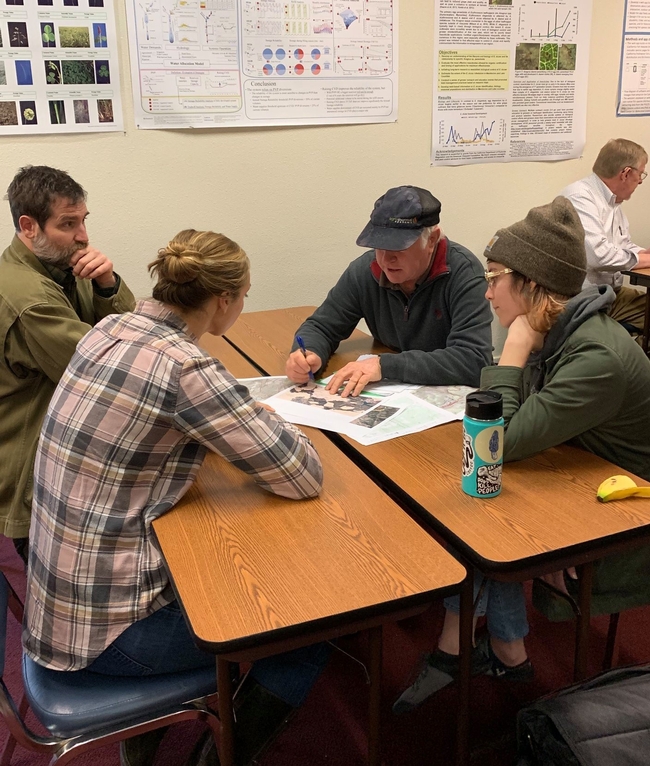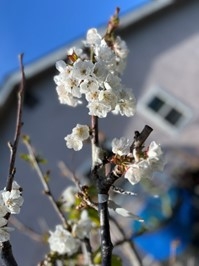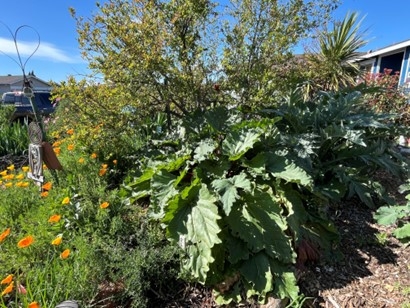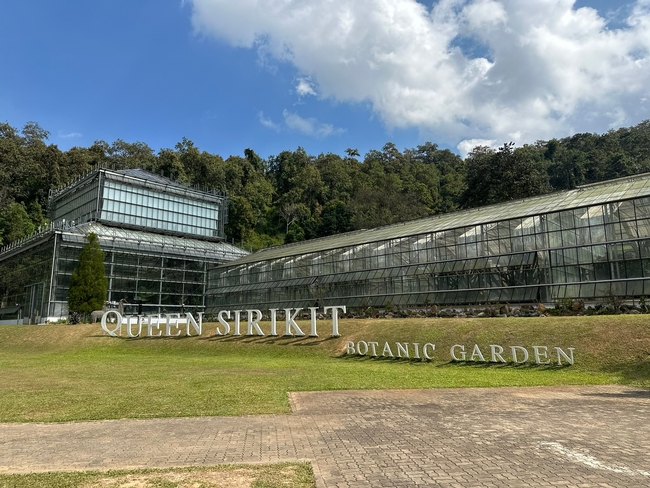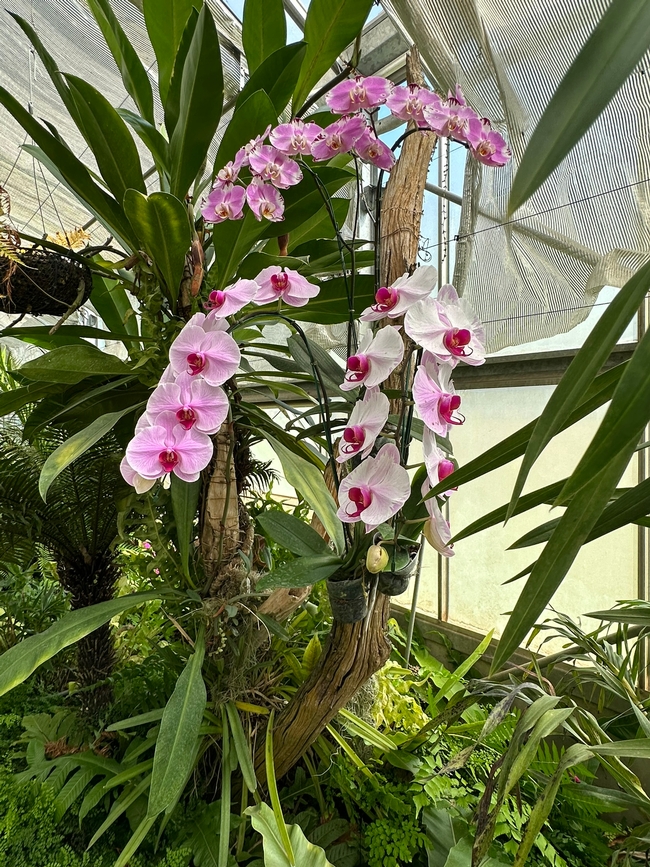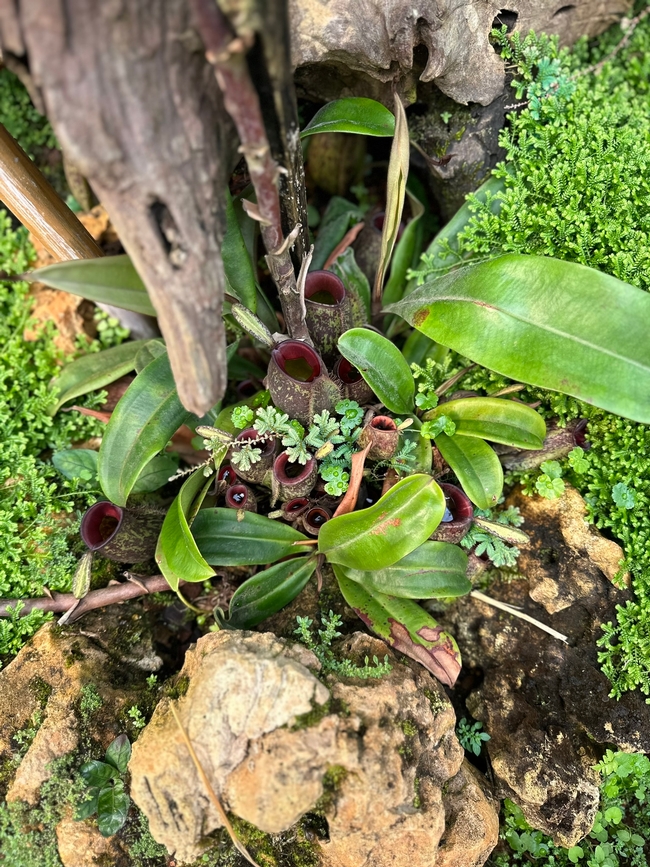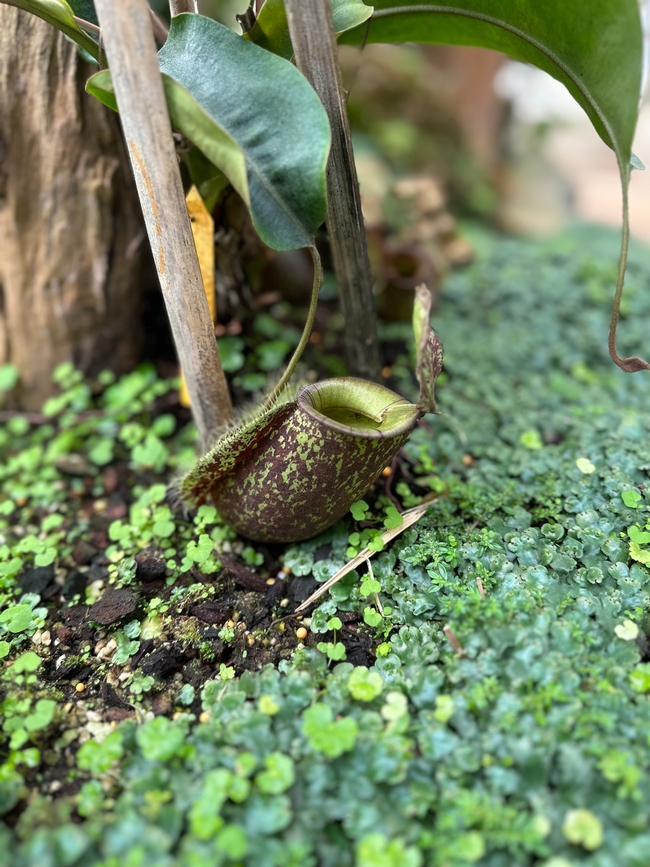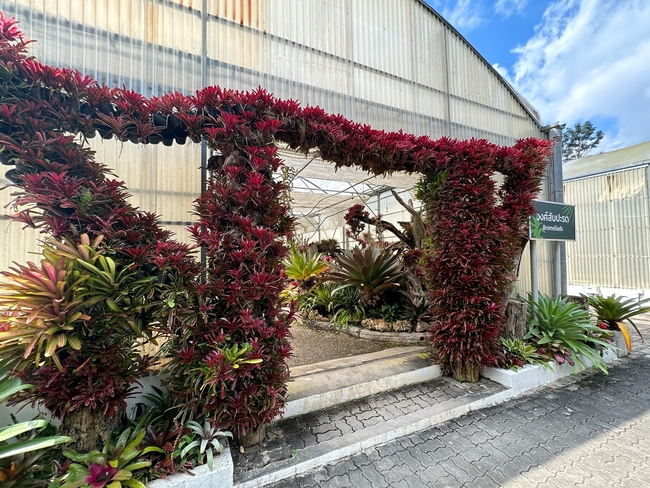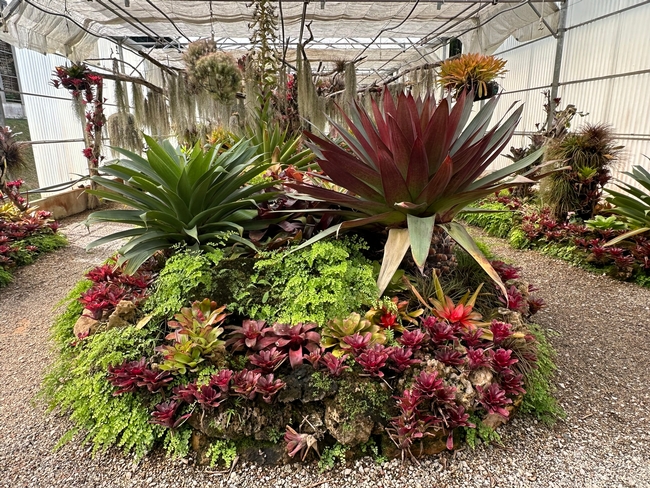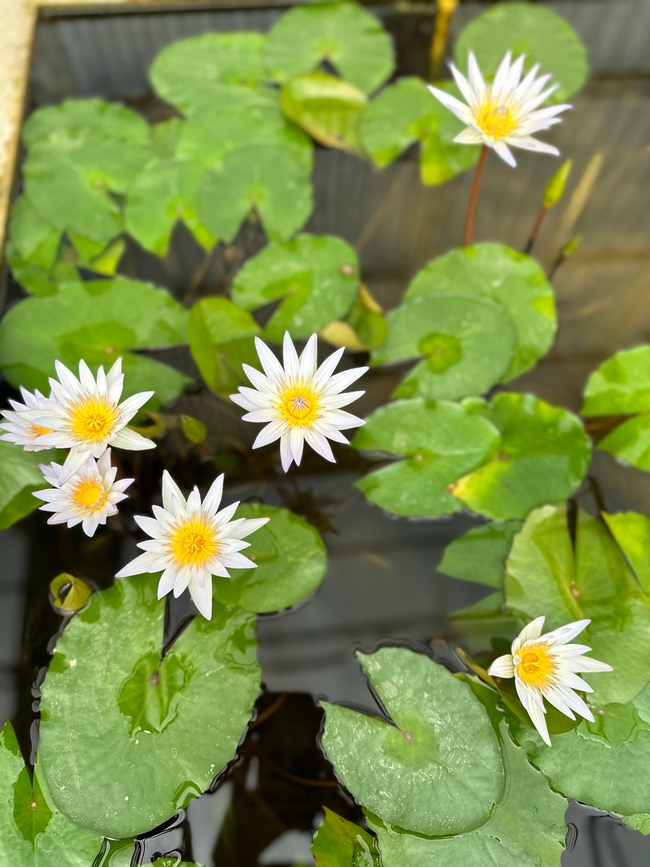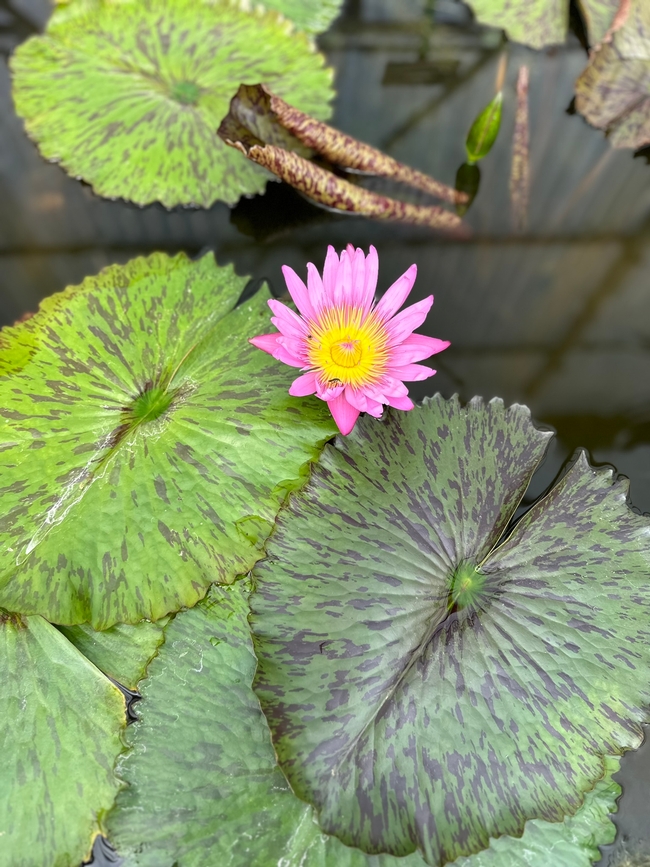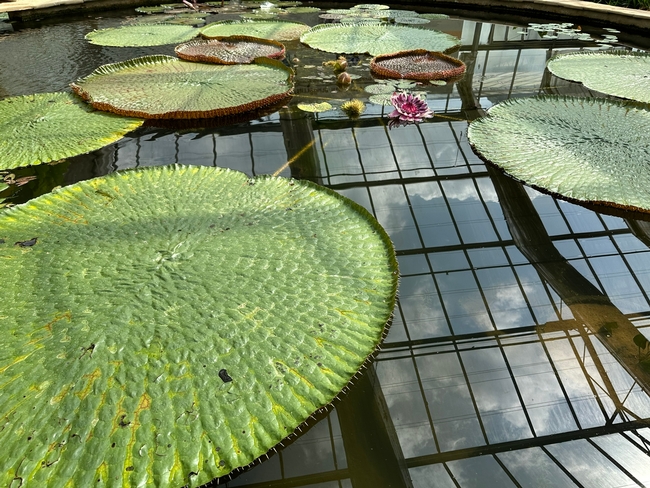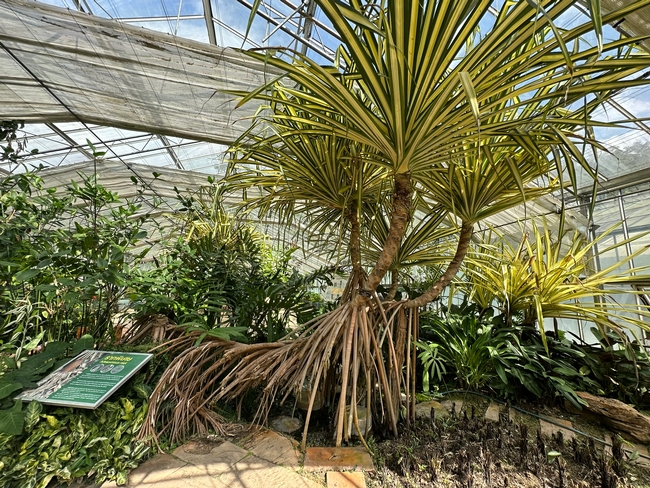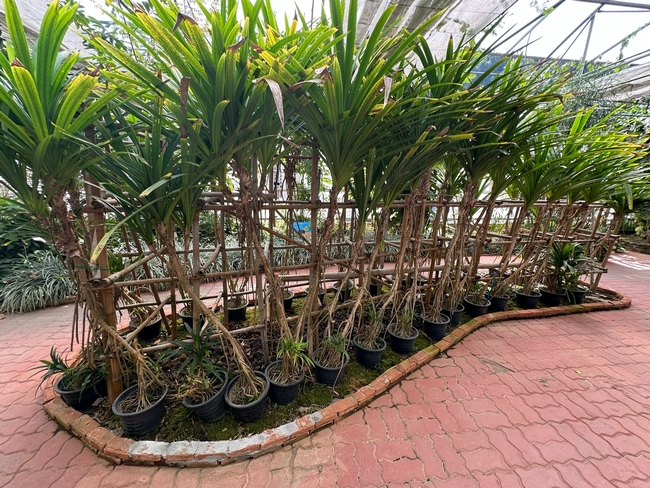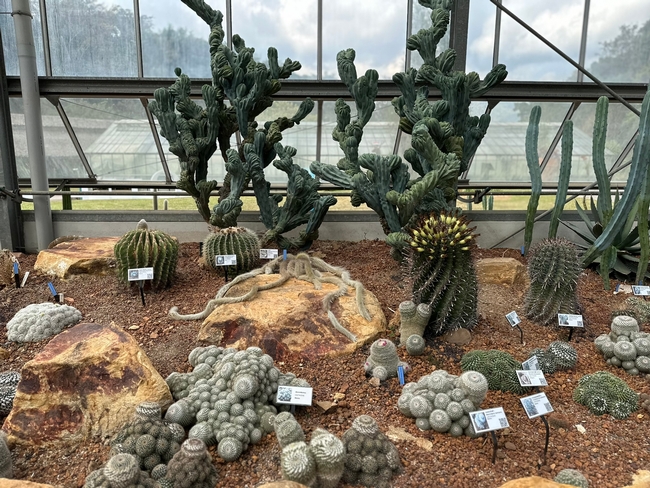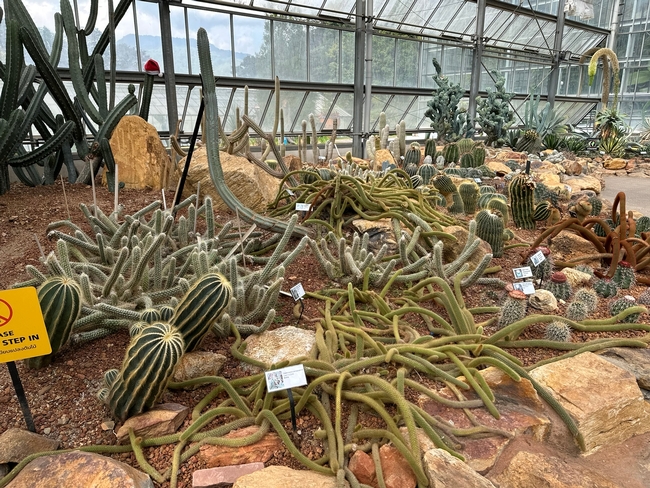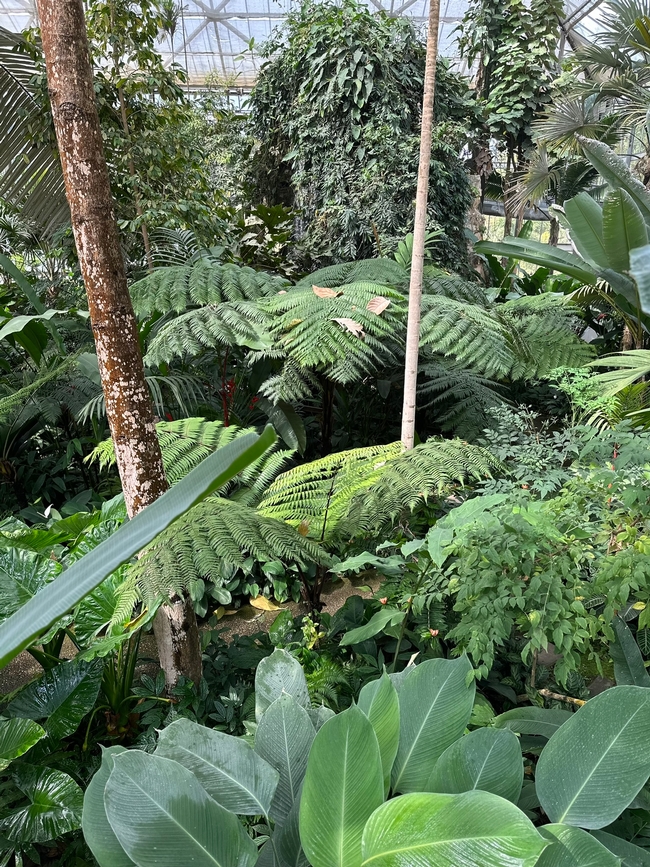UC Blogs
Connecting California’s forest landowners with California Tree School
While trees and forests are often emblematic of constancy in a fast-paced world, our state's forests are actually changing before our eyes. Since 2020, the UC ANR Forest Stewardship Education (FSE) program has been helping California's forest landowners be proactive about the inevitable shifts their forestland will experience. The Forest Stewardship and Post-Fire Forest Resilience workshop programs use an online educational format, which guide landowners through the basics of creating forest management plans and managing post-fire landscapes, respectively. Now, the FSE team is piloting a new program to engage a wider audience of forest landowners and community members passionate about trees.
This spring, the Forest Stewardship and UC ANR Fire Network teams are holding the first California Tree School, where individuals attend multiple in-person classes on the forestry topics they are most curious about. “The existing online programs are very focused on forest management plans and post-fire activity, and [Tree School] lets us tackle other topics,” said UC ANR forest and natural resources advisor Susie Kocher.
A one-stop shop for continuing forestry education
California Tree School was inspired when Forest Stewardship Academic Coordinator Kim Ingram, Post-fire Academic Coordinator Katie Reidy and Kocher attended Oregon State University Extension's Tree School event in Clackamas County, Oregon. OSU Tree School is a day-long experience comprised of classes that cover the different dimensions of forestry: constructing a house from your own timber, carbon cap and trade, and buying portable sawmills are just a small sampling of the options for attendees. OSU Tree School students ranged from forest landowners to community college students, contributing to a space which would facilitate community connections as well as learning.
Kocher described the experience as a “a great one-day, one-stop shop to keep up-to-date on what we [forest landowners and professionals] should know.” Excited by the breadth of opportunities offered at OSU's Tree School, Ingram, Kocher and Reidy were inspired to bring the format to California.
“It's our time to discuss the whole ecosystem,” noted Reidy. “Tree School is bringing in the trustworthy, reliable group of experts who can provide more information on the questions pertaining to landowners' specific goals.”
California Tree School will be offered in two locations this spring, with CA Tree School- Hopland taking place on May 4, and CA Tree School- El Dorado on June 1. Similar to OSU's Tree School, attendees are expected to be a mix of forest landowners, natural resource professionals and interested community members.
Connecting statewide professionals; personalizing forestry education
Tree School offers attendees the opportunity to focus on subjects that pertain to their specific learning needs. This personalized approach is a new foray for the Forest Stewardship team, but is something that Ingram says workshop participants have been wanting for some time.
“Our participants never think they learn enough. They are always asking for more information, and this Tree School gives us the chance to expand on things we might not have had a chance to go over in the workshop series,” remarked Ingram. Additionally, Tree School instructors had creative freedom when it came to developing their classes, from the topic to the class format. This is evident when browsing through each session's class catalog. CA Tree School attendees choose four classes to attend, meaning they can build their first burn pile, understand the ins and outs of regional wildlife, paint outdoors and learn how to aid statewide reforestation efforts all in one day.
“I felt that Tree School created a sense of trust around complex topics,” noted Reidy about her experience last year in Oregon. For CA Tree School, the Forest Stewardship team aims to do the same. This meant recruiting from throughout the UC ANR network and other organizations, including CALFIRE and CARCD (California Association of Resource Conservation Districts), to bring trusted voices to the community.
“What's exciting about Tree School is that we are bringing natural resource professionals from all around to engage everyone at the same time, and all in one place,” noted Ingram.
The team is excited to see all the connections that will be made between community members and professionals during this pilot year, and “if this is successful and we can bring it back next year,” commented Kocher, “we are definitely interested in partnering with more people and expanding our outreach.”
Making CA Tree School an in-person experience was important to the team, as much of the education is hands-on. Additionally, Kocher sees enhanced potential for building personal connections: “In person, you have this opportunity for people to identify as part of a community,” noted Kocher, “So I'm excited for people to hang out with each other.”
Encouraging an informed community
“You can't separate the emotional from the physical, and there are a lot of topics in forestry like wildfire and economics that can be a bit of a downer,” said Ingram. “I'm excited to help create a positive learning environment, and one that encourages folks to turn to UC Cooperative Extension for these resources.”
“Our main goal here is to get science out there,” concurred Reidy. “The more exposure people have to science, the more confident they feel in themselves and their wants and needs.”
Spring is Here!
There's a verse in a song that starts off like this, “It's a wondrous time in spring, when all the trees are budding,
the birds begin to sing, the flowers start their blooming”… Those are exactly what I have been observing.
With all the rain we've received last winter, the light green leaves of the persimmon (Diospyros kaki) tree covers what has been a dreary looking skeleton of branches. The olive (Olea europaea) tree leaves are so abundant they are criss-crossing in every way — note to self: cut-off the crossing branches. The ‘Black Pearl” graft on the cherry tree has flowers on the grafted stem.
I hear the birds singing from every open window of the house. The red freesias are the envy of friends, and the California poppies (Eschscholzia californica), the California state flower, are all over the front yard. The rhubarb plant has abundant fresh gigantic leaves and striking red stems, as if saying, “I'm here you can't ignore me.” Everything feels fresh and exhilarating, and I want to see and do everything.
A few years ago, I built a rustic potting bench for myself in the side yard. I've tweaked it a few times over the years. I re-organized and cleaned it up.
I'm finally happy with how it turned-out, for now.
What's next?
The Spring Plant Exchange is coming up soon, where we bring a plant from home, and take a plant (or 2) home. Here's a link to the Master Gardener website that also shows other upcoming events. April 20 from 9 am until 1 pm at the UC Cooperative Extension office, 501 Texas Street, Fairfield.
“It's fresh like spring, I want to sing, I want to pass it on.”
Breathtaking Bluebonnets and Butterflies
If you've never been to the 284-acre Lady Bird Johnson Wildflower Center at the University of Texas, Austin, in the spring to see the flora...
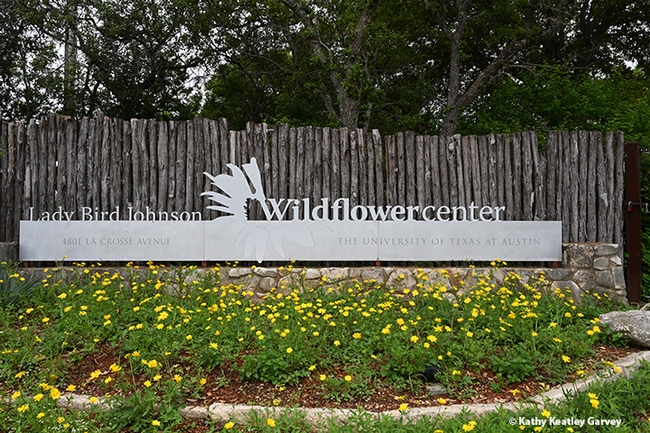
Signage at the 284-acre Lady Bird Johnson Wildflower Center at the University of Texas, Austin, welcomes visitors. (Photo by Kathy Keatley Garvey)
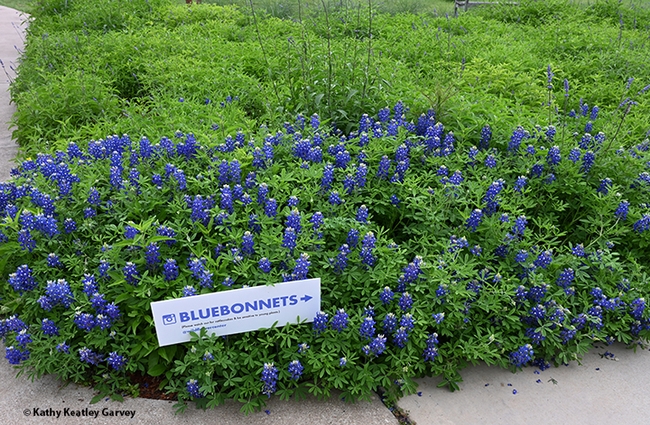
A bluebonnet sign warns visitors of rattlesnakes. (Photo by Kathy Keatley Garvey)
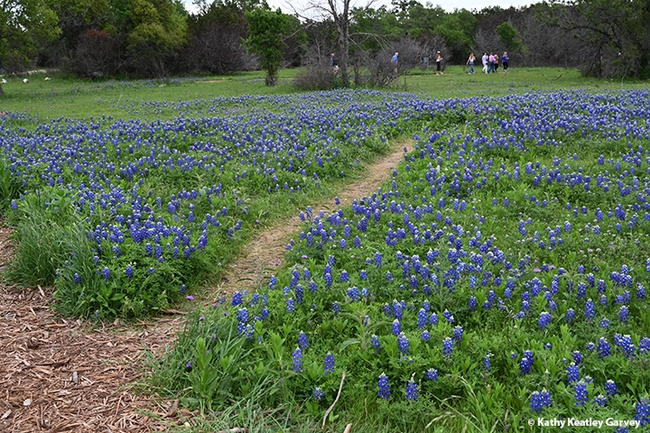
Visitors are to stay on the path at the Lady Bird Johnson Wildlower Center. This image was taken on Easter Sunday. (Photo by Kathy Keatley Garvey)
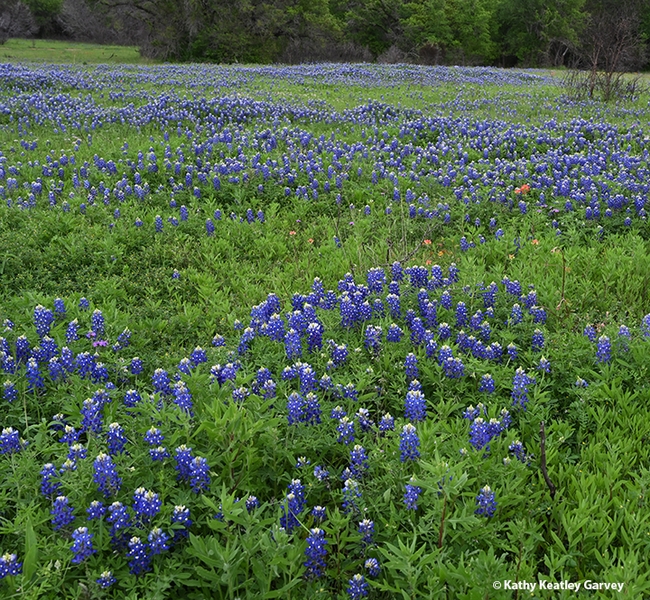
The bluebonnets were spectacular on Easter Sunday. (Photo by Kathy Keatley Garvey)
Educational and Fun Activities at the UC Davis Bee Haven Open House
Catch and release. Release and catch. No, wait. Catch...examine...and then release. That's what attendees will do at the UC Davis Bee Haven's...

An educational and fun activity: the catch-and-release bee activity at the UC Davis Bee Haven. (Photo by Kathy Keatley Garvey)
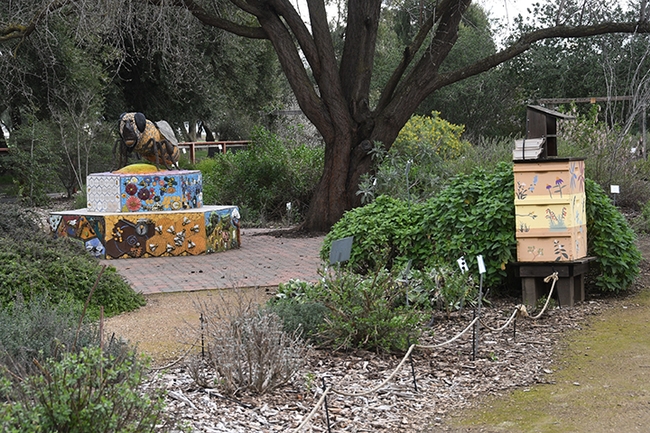
A six-foot-long worker bee sculpture, the work of Donna Billick of Davis, anchors the UC Davis Bee Haven. (Photo by Kathy Keatley Garvey)
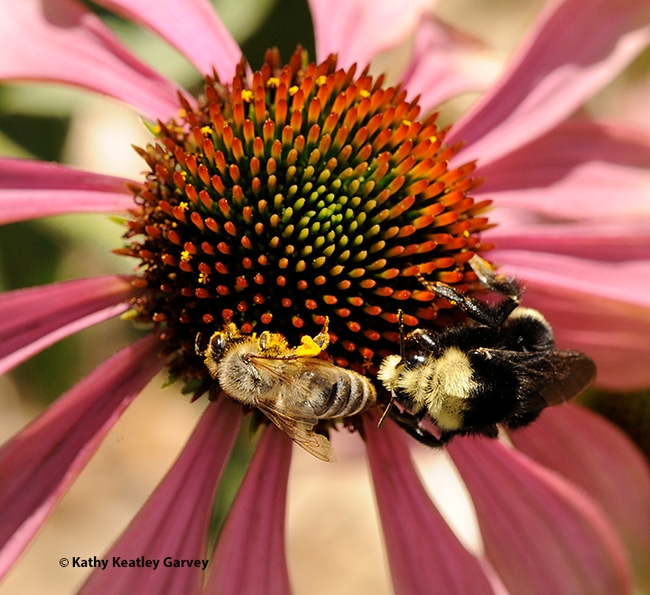
A honey bee and yellow-faced bumble bee, Bombus vosnesenskii, share a purple coneflower in the UC Davis Bee Haven. (Photo by Kathy Keatley Garvey)
My Thailand Vacation Adventure at the Queen Sirikit Botanic Garden (Part 2)
Themed Plant Collections in 8 Glasshouses
INCREDIBLE! That was my first thought at seeing the Glasshouse Complex at the Queen Sirikit Botanic Garden. Which boasts 8 glasshouses, each housing captivating themed plant collections. I could not wait to explore each one of them!
Orchid Conservatory:
This glasshouse is dedicated to a diverse collection of orchids species showcasing their diverse forms each with its unique colors, shapes, and patterns.
The environment inside the glasshouse is carefully controlled to mimic the ideal conditions for orchids. It provides the right balance of humidity, temperature, and light to support their growth.
As I explored, I was surrounded by vibrant orchids in full bloom.
The Orchid Conservatory also educates visitors about the fascinating world of orchids. I learned about their life cycles, pollination mechanisms, and ecological significance.
Carnivorous Plant House:
I stepped into a mysterious world where plants devour insects! The Carnivorous Plant House features pitcher plants, Venus flytraps, and sundews. These fascinating botanical predators thrive in nutrient-poor soils by capturing their prey.
These unique plants have evolved to capture and digest insects as a source of nutrients. They thrive in nutrient-poor environments where other plants struggle.
Carnivorous Plant Collection:
Pitcher Plants: These plants have specialized leaves that form pitcher-like structures. Insects are lured into these pitchers, where they become trapped and eventually digested by enzymes.
Venus Flytraps: Iconic for their rapid-snapping traps, Venus flytraps close around unsuspecting insects when triggered by touch.
Sundews: These plants have sticky, glandular hairs on their leaves. When an insect lands on them, the hairs curl, ensnaring the prey.
Why do they eat insects? Carnivorous plants grow in nutrient-deficient soils. By consuming insects, they supplement their diet with essential elements like nitrogen and phosphorous
Bromeliad Pavilion:
A tropical paradise!
These fascinating plants belong to a family of approximately 2,400 species, primarily found in the tropical Americas. They come in an astonishing variety of shapes, sizes, and colors.
Shadehouse Setting: Unlike a traditional glasshouse, the Bromeliad Pavilion provides a shaded environment that mimics the natural conditions where bromeliads thrive. It's a haven for these unique plants.
Year-Round Beauty: The displays are meticulously maintained and updated throughout the year to showcase the bromeliads that are currently at their best.
Water Lily Pavilion:
Here, I found elegant water lilies floating on serene pools. Their broad leaves and blossoms create a calming oasis. Keep an eye out for the elusive Victoria amazonica, with leaves that can support the weight of a small child!
Plant Diversity: The pavilion shelters over 100 species of aquatic plants, including those that thrive at the edges of rivers, lakes, ponds, streams, and marshes.
Water lilies and lotus plants are the stars of this aquatic show.
Victoria Amazonica: One special attraction is the extra-large leafed Victoria amazonica. This giant water lily hails from South America. Its leaves are capable of holding the weight of a small child! Imagine standing on a lily pad—it's quite a sight.
Colorful Blooms: As you explore the pavilion, you'll encounter a colorful array of water lilies and lotus flowers. Their blossoms float serenely on the water's surface.
It's a peaceful spot to escape the hustle and bustle of everyday life.
Fern House:
I ventured into the cool Fern House, where lush green fronds unfurl. Ferns, with their intricate patterns, thrive in this humid environment.
The Fern House showcases an impressive collection of fern species.
These ancient plants have delicate fronds that unfurl gracefully and thrive in this cool, shaded environment.
Aroid Gallery:
A feast for foliage lovers! The Aroid Gallery celebrates plants from the Araceae family. Marvel at monsteras, anthuriums, and the iconic Swiss cheese plant.
Araceae Family: The Araceae family, also known as the aroid family, includes a wide range of fascinating plants.
These plants are characterized by their unique foliage, often glossy and lush.
As you step into the Aroid Gallery, you'll encounter some iconic members of this family:
Monsteras: Known for their large, fenestrated leaves (with holes or splits).
Anthuriums: With their heart-shaped, colorful spathes (modified leaves) surrounding a spike (spadix).
Swiss Cheese Plant (Monstera deliciosa): Famous for its hole-riddled leaves.
Philodendrons: Diverse in shape and size, these climbing or trailing plants are popular houseplants.
Leaf Shapes and Sizes: The Aroid Gallery showcases an array of leaf forms—some broad and palm-like, others deeply lobed or arrow-shaped.
Look closely at the intricate veining and patterns on these leaves.
Tropical Vibes: The glasshouse provides a warm, humid environment, reminiscent of tropical rainforests where aroids naturally thrive.
It's like stepping into a mini jungle!
Desert Succulent Pavilion:
The Desert Succulent Pavilion showcases resilient cacti, agaves, and euphorbias. These water-wise plants have adapted to survive harsh conditions, storing moisture in their thick stems and leaves.
Plant Collection:
Cacti: These desert dwellers hail from arid regions of America, including Mexico, Peru, and Brazil. Their unique shapes, spines, and ability to store water make them true survivors.
Agaves: These succulents also thrive in arid climates. Their thick, fleshy leaves store water, allowing them to withstand drought.
Arid Beauty: As you explore the pavilion, you'll encounter a fascinating array of cacti and agaves. Some have intricate patterns, while others boast imposing spines.
The Desert succulents have evolved remarkable adaptations to survive in harsh conditions. Their water-storing tissues and reduced leaf surfaces help them thrive where rainfall is scarce.
Educational Experience: I learned about the unique biology and ecology of these desert plants.
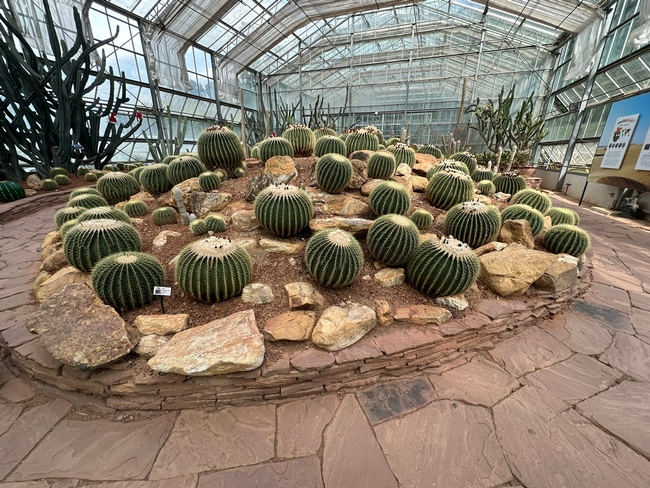
Tropical Rainforest House:
The Tropical Rainforest House replicates the dense vegetation of tropical jungles. Towering palms, philodendrons, and epiphytic orchids thrive here, creating a canopy.
The Tropical Rainforest House within the Queen Sirikit Botanic Garden (QSBG) is the largest conservatory in the Glasshouse Complex.
Size and Setting: The Tropical Rainforest House covers an impressive 1,000 square meters with a soaring height of 33 meters.
It's designed to recreate the lush environment of a southern Thai rainforest.
Tropical Species: Inside, you'll find a diverse collection of tropical plants, including Palms, Bananas, and Gingers.
Humidity and Greenery: The glasshouse maintains high humidity, mimicking the rainforest's moist conditions.
Towering palms, broad leaves, and hanging vines create a dense, green canopy.
Educational Experience: I learned about rainforest ecosystems, plant adaptations, and the vital role rainforests play in our planet's health.
I enjoyed spent hours exploring the 8 glasshouse each having its' unique theme. However, out of all them my favorite was the Desert Succulent Pavilion.
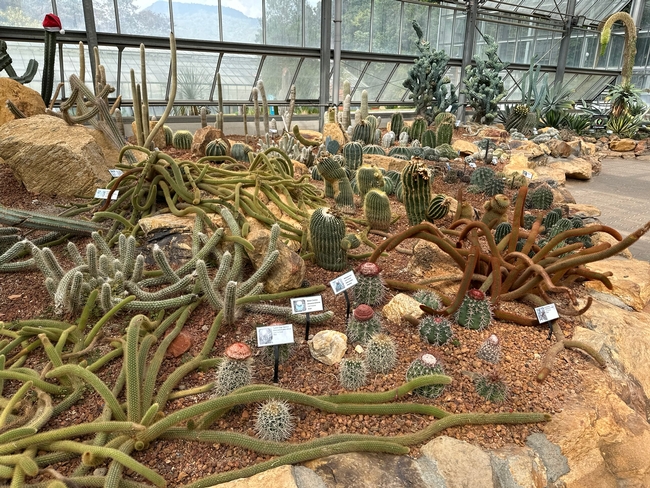
IMG 3882


